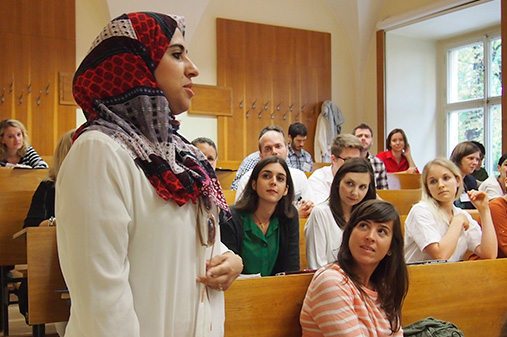Highlights in Movement Disorder Education | Congress 2022
[00:00:00] Sara Schaefer: Welcome back to the MDS Congress special series for 2022. I am Sara Schaefer from the Yale School of Medicine. And with me today is Veronica Santini, also from the Yale School of Medicine. She's an associate professor of neurology there as well as the chair of the CME committee for the Movement Disorder Society and a member of the Congress Scientific Programming Committee.
Today, I'm gonna be speaking with her about medical education in the field of movement disorders. Welcome.
[00:00:36] Veronica Santini: Thanks so much for having me, Sara.
View complete trasnctipt
[00:00:38] Sara Schaefer: So why don't you tell me about some of the exciting things that are happening with the society in the field of medical education.
[00:00:47] Veronica Santini: Well, I think one of the things that is really amazing about the society in recent years is its push to engage younger members.
And I think this happens at all levels. So members are able to engage better by focusing on fellowship education and movement disorders, and also inviting speakers that really show a breadth of diversity in our Congress.
[00:01:15] Sara Schaefer: Are there any particular offerings at this meeting or any other meetings that you feel like the listeners should know about or educational offerings from the society at other times of the year?
[00:01:29] Veronica Santini: I think what you're gonna see from the society at this Congress and at upcoming congresses is that we really wanna tailor programming. Such that we can focus on sort of various tracks that somebody may attend. So some of the more kind of, not basic, but sort of fun, fundamental learning opportunities. And then some of those more advanced opportunities, I think you may have had an opportunity to attend the young members reception and you can see that there's a number of networking events for young members and for fellows.
[00:02:04] Sara Schaefer: Absolutely. My understanding is that the young members group actually makes up about 45% of the people in the society, which is an enormous number. So the up and coming.
[00:02:16] Veronica Santini: And Sara, that's a really important point because that's changed in recent years. So I think that demonstrates really an effort by the society to engage younger members and to engage our fellows so that we can train that next generation of movement specialists.
I think the number one goal, when we think about what we wanna do, our vision is to really ensure that our patients are getting excellent care across the globe. And that means training of the next generation of specialists.
[00:02:48] Sara Schaefer: Can you tell us about any particular initiatives to try to reach out to members and groups in movement disorders that might have less access to educational programming?
[00:03:02] Veronica Santini: Yeah, Sara, that's a really important point because I think as you can see from the programming in the Congress, diversity is a very important measure that the society wants to have.
We wanna engage all of our global membership. Recently there was an amazing course that was offered online. That was both asynchronous and synchronous learning that included members in. Where movement disorder specialists may be few and far between and creating community can be a very important point in that kind of education.
So this was a great course that people were able to engage on an online platform, kind of submit homework assignments and also view prerecorded lectures. I think that is one amazing example of how we can broaden our educational opportunities for international colleagues.
[00:03:55] Sara Schaefer: And what about the pipeline? You know, and trying to target undergrads, medical students, neurology residents early, so that they get exposure to movement disorders and may choose our sub-specialty when otherwise they might go towards stroke or something else that they get a little bit more exposure to.
[00:04:16] Veronica Santini: Yeah. That's a very good point. I think not enough can be said about the excitement that is created in movement disorders and transferring that excitement to early, early, early trainees, right? Those medical students. How many medical students have you personally interviewed for residency or for fellowship where the initial stimulus for them to come into movement disorders was watching that encounter with a DBS patient. Seeing them transform before their eyes. So I think the true patient engagement can't be understated. We also know tons of medical students and tons of trainees are interested in neuroscience research. And so showing them the applicability of neuroscience within our field is a way to really attract those younger members.
But if you take it all the way up, then we can't forget about fellowship training. Even that word fellowship is such a U.S. Centric word in movement disorders. It doesn't exist in many of our colleagues countries. And so I think we need to start really thinking about transforming the ideas of this subspecialize training.
What does it mean? What does a core curriculum look like? And can we utilize things like milestones? For instance, you may know a little bit about that.
[00:05:37] Sara Schaefer: Just a little.
[00:05:38] Veronica Santini: That really start to standardize therapy. Now what about those institutions that may not have all of the resources that some of the highest level institutions have. Well, this is a great opportunity for partnership.
And I think mandatory, we have an obligation really, to partner with institutions that may not have a DBS surgeon for instance, so that trainees across the globe can get that highly specialized training. And what that means is our patients will get good care no matter where they are
[00:06:14] Sara Schaefer: All very important points. Anything else you want to add?
[00:06:17] Veronica Santini: Well, I'm super thrilled to be here. I think we also have to make sure that we support our educators. So highest level educators and also educators at the levels of high school, medical school, college. Right? We have to be able to support the educators who are putting in the work for our trainees and ensure that they know that their work is valued and that it is something that the society really supports. In doing so then we will really train the next generation of experts.
[00:06:51] Sara Schaefer: Can't agree with you more. Thank you so much, Veronica.
[00:06:56] Veronica Santini: Thanks so much, Sara.

Veronica Santini
Associate Professor of Neurology
Yale School of Medicine
Chair, MDS Continuing Medical Education Committee
Member, Congress Scientific Programming Committee (CSPC)









